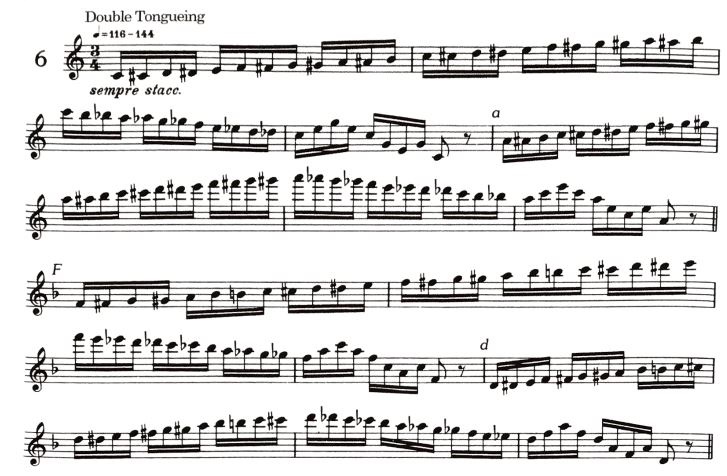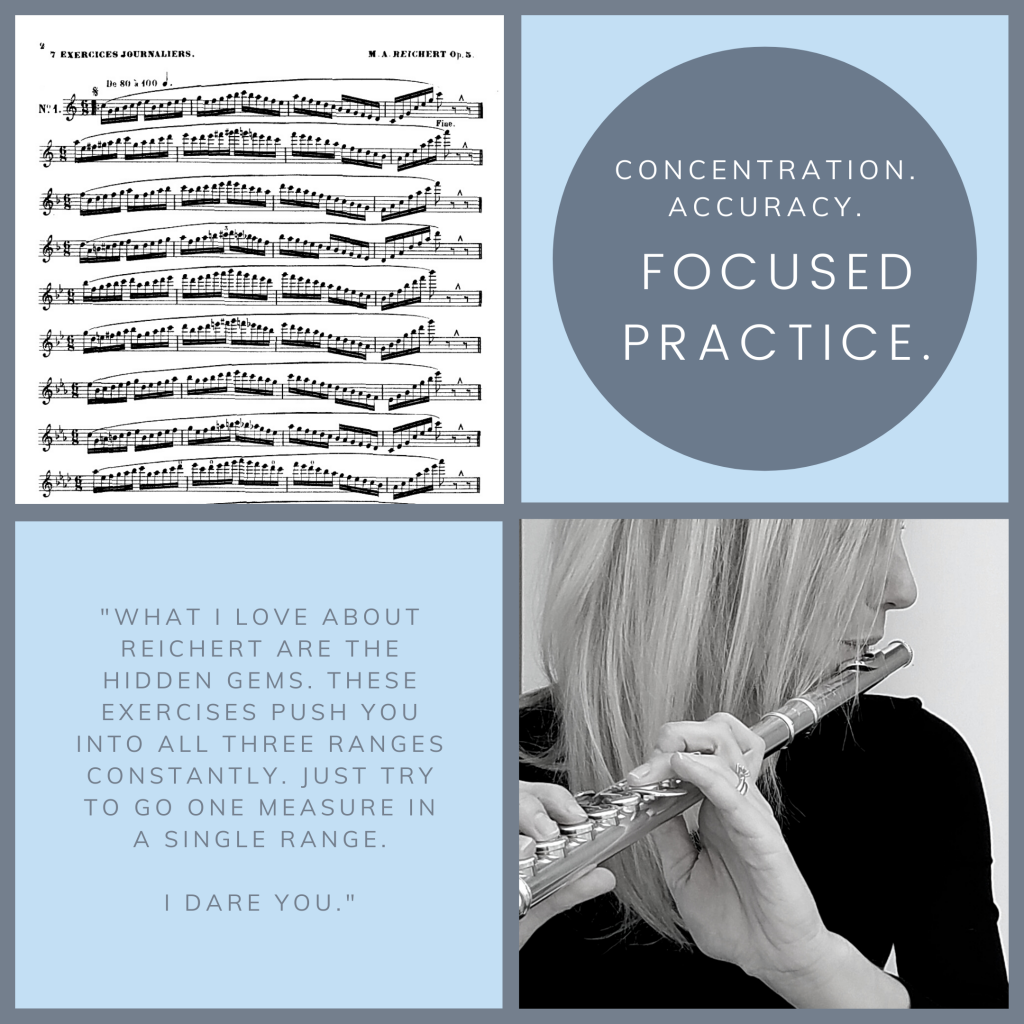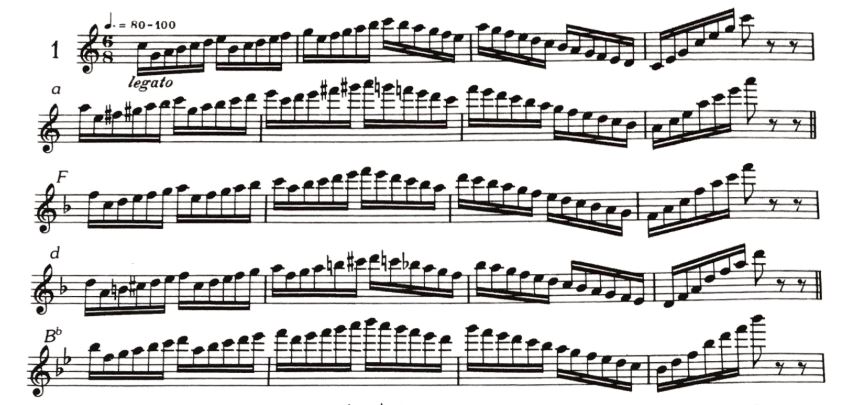Who loves practicing? I do, I do!
Okay, who doesn’t love countless hours of isolation with your stand and music? If you are an introvert, that probably sounds like heaven, right?
Actually, really good, quality practicing can be enormously satisfying – and good for the brain – but the clock is always ticking away, and there are never enough hours in the day. Can I get an Amen?!
So, how do you make the most of the time you have, as you strive to be at your best? First, pay attention to WHAT you are practicing. Countless flute lessons, masterclasses, and years of private study (and teaching some pretty awesome students) have brought me through abounding pages of etude books and studies. And my favorite technical flute study – hands down – REICHERT.

Why is Reichert so great?
The Seven Daily Studies by Belgian composer, Mathieu André Reichert is the best. It is short, to the point, and gets the job done. Many of my university students are jazz players, hoping to master the flute in just four short years. Without a doubt, I encourage them each to purchase the Reichert book and work towards mastery.
With just seven exercises, the advanced flutist can play through the entire book for a technical warm up – and I’ll tell you what. You’re ready to GO afterwards! Beginners and intermediate level flutists who have learned the basic major and minor scales can dive into Reichert early on and enjoy a little deviation from straightforward scales.
Simply put, the exercises are useful and fun. For everybody!
Don’t have a copy yet? Grab Reichert here.
Make the most of your practice

So, let’s talk about how to grow as a flutist with daily Reichert practice.
First, it is important to remember that each of the seven exercises has a wide range of possibilities. Let’s take No. 6. At first glance, it just looks like a basic articulation exercise, based on the chromatic scale.

Yes, that is true, but if you dig deeper, there is more to be found! What I love about Reichert are the hidden gems. These exercises push you into all three ranges constantly. Just try to go one measure in a single range. I dare you.
That said, explore some of these practice strategies…
- Stand firmly, feet slightly apart and feel as if you are growing roots into the ground. Release all tension in your neck and shoulders (repeat offenders!) so you are free to concentrate solely on finger movement. Though you are reading staccatos, strive for a legato, streamlined finger movement throughout the exercise.
- Try putting on a metronome (subdividing beats) – with earbuds or using your Soundbrenner, if you want to get really fancy. Feel the vibration and match each sixteenth perfectly. Line up the start of each note with the beat. Listen for inconsistencies and expand your sound to find a fullness, even within the tiny space of a sixteenth.
Ideas like this will increase concentration and accuracy and will have big implications when you transfer them into your repertoire.
- Another thought is to change your articulation. Try experimenting beyond the basic TKTK double tonguing and try “Dah-gah, dah-gah” or even “chu-gah, chu-gah.” Or, to increase strength, practice by REVERSING the syllables to reinforce your weaker, secondary syllables. It’ll sound a little strange at first, but it helps even everything out.
- And what about regrouping? When you give this exercise a good stare, looks like four sixteenths to a beat, three beats in a measure, right? What if you regroup into two groups of 6 per measure? Tricks like this can lead to a higher level of accuracy and precision.
- Another area to explore is expression. Play the line with nuance and color. See if you can you maintain a sparkling tone at a piano dynamic. Most importantly, strive to phrase with quality, even with that driving metronome in your ear. It’s a considerable challenge.

Inspired to give it a try? Keep reading… your flute will be so excited to try these out in a few minutes!
How about Reichert No. 1? My fav. This one is all about projection and opening up your capacity for a big sound.

- Try this one singing and playing (sounds more like buzzing the throat or growling and playing). This does wonders to open up the back of the throat for maximum fullness of sound. The “singing” forces the back of the tongue down and opens up that airway! This can help smooth out all of the transitions between notes.
- Regrouping in this one is huge as well. Groups of 2s, 3s, 4s, & 6s are my go-tos. It’s also fun and useful to hold out the first note of every grouping of 6. Remember, in Reichert, it’s all about efficiency. Make it your technique, phrasing AND tonal warm up, all in one!
- Okay, let’s talk high register. There is no avoiding it in Reichert. You are headed up, no turning back. You must have proper breath support and a whole lot of courage. Spending quality time in the stratosphere can be hard, but proves SO useful. Don’t skimp here. Use the strength from your core muscles to push you gracefully up the scale. Well, maybe not so gracefully at first!
- The final arpeggio in this exercise (last measure of each key) is important. I like to isolate it; playing backwards and forwards and sometimes even adding my own descending chromatic resolution. Ah, why not?
Last, but not least…
Tackling intervals confidently and maintaining the beauty and fullness of the flute sound can be tricky. When you travel through intervals and arpeggios quickly on the flute, the sound can “break”. It’s important to go beyond scale practice to really iron out those breaking points in your sound. Once you can do this though, you can be confident you’re warmed up and ready to play just about anything.
My favorites for interval practice are Reichert No. 2 & No. 4. Take a look. They are simple, but really warm up your fingers and sound.


- When learning these for the first time, take them really slowly so you can concentrate and memorize the finger pattern. Feel your fingers move and try to keep that movement to a minimum. In No. 4, focus specifically on areas of transition, like between the leading tone turn figure (Ex. A, G, F#, G or D, C, B, C in measure 1).
- Keep the throat dropped and open, like a yawn, as much as possible and use core muscles to “blow through” and connect all the notes. Also, strive to give fullness and depth to the lower notes in each arpeggio. The higher notes will come out more easily, but reach for the rich sound and support on the bottoms.
- As an added challenge, consider reading each key first as written and then either up or down the octave, depending on what is appropriate or doable.
Most of all, HAVE FUN and enjoy setting new goals and exploring the endless possibilities!
Best of luck,

Want more great flute practice resources? Visit my resource page to check out some favorites!
How about you? How do practice Reichert? Be sure and comment in the section below!



